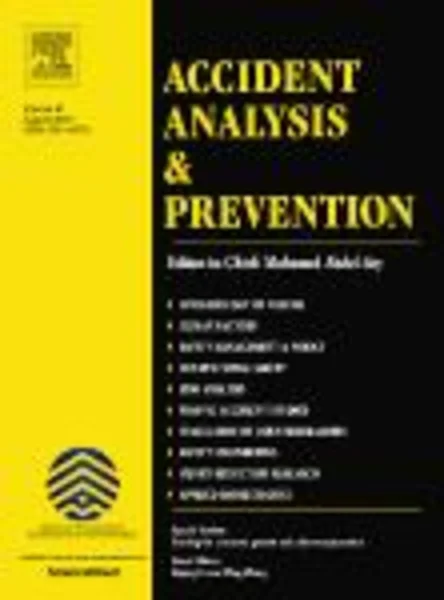-
investigating the factorial invariance of the 28-item dbq across genders and age groups: an exploratory structural equation modeling study
جزئیات بیشتر مقاله- تاریخ ارائه: 1392/01/01
- تاریخ انتشار در تی پی بین: 1392/01/01
- تعداد بازدید: 685
- تعداد پرسش و پاسخ ها: 0
- شماره تماس دبیرخانه رویداد: -
the driver behaviour questionnaire (dbq) is perhaps the most widely used questionnaire instrument in traffic psychology with 174 studies published by late 2010. the instrument was developed based on a plausible cognitive ergonomic theory (the generic error modeling system, gems), but the factor structure obtained in the original study (reason et al., 1990) did not mirror the theory's conceptual structure. this led to abandoning gems and adopting the obtained factor structure as a starting point for further dbq research. this article argues that (1) certain choices in the original study, concerning statistical methodology and the wording of individual question items, may have contributed to the ways the obtained factor structure deviated from the underlying theory and (2) the analysis methods often used in dbq studies, principal components (pc) analysis and maximum likelihood (ml) factor analysis, are not optimal choices for the non-normally distributed categorical data that is obtained using the instrument. this is because ml produces biased results when used with this type of data, while pc is by definition unable to uncover latent factors as it summarizes all variation in the measured variables. (3) even though dbq factor scores have been routinely compared in subgroups of men and women and respondents of different ages, dbq's factorial invariance in these groups has not been rigorously tested. these concerns are addressed in this article by framing the results of certain previous dbq studies as a structural equation model (sem) and an exploratory structural equation model (esem) and testing measurement model fit in subgroups of respondents. the sem analyses indicate that the model does not fit data from the whole sample of respondents as it stands, while the esem analyses show that a modification of the model does. however, the esem analyses indicate the dbq measures different underlying latent variables in the different subgroups. based on the analyses and a review of recent advances in attention and memory research, an update to the theory underlying the dbq is suggested.
مقالات جدیدترین رویدادها
-
استفاده از تحلیل اهمیت-عملکرد در ارائه الگوی مدیریت خلاقیت سازمانی و ارائه راهکار جهت بهبود
-
بررسی تاثیر ارزش وجوه نقد مازاد بر ساختار سرمایه شرکت های پذیرفته شده در بورس اوراق بهادار تهران
-
بررسی تأثیر سطح افشای ریسک بر قرارداد بدهی شرکت های پذیرفته شده در بورس اوراق بهادار تهران
-
بررسی تأثیر رتبه بندی اعتباری مبتنی بر مدل امتیاز بازار نوظهور بر نقد شوندگی سهام با تأکید بر خصوصی سازی شرکت ها
-
تأثیر آمیخته بازاریابی پوشاک ایرانی بر تصویر ذهنی مشتری پوشاک ایرانی (هاکوپیان)
-
بررسی حکمت متعالیه در طراحی معماری
-
روش های ایجاد انگیزه تحصیلی و یادگیری در دانش آموزان
-
بررسی تأثیر خواص پتروگرافی بر مقاومت تراکمی نامحصور و رفتار تنش- کرنش شیل های سازند شمشک
-
simulation of fluid-solid interaction on water ditching of an airplane by ale method
-
factors affecting cellular lipid extraction from marine microalgae
مقالات جدیدترین ژورنال ها
-
مدیریت و بررسی افسردگی دانش آموزان دختر مقطع متوسطه دوم در دروان کرونا در شهرستان دزفول
-
مدیریت و بررسی خرد سیاسی در اندیشه ی فردوسی در ادب ایران
-
واکاوی و مدیریت توصیفی قلمدان(جاکلیدی)ضریح در موزه آستان قدس رضوی
-
بررسی تاثیر خلاقیت، دانش و انگیزه کارکنان بر پیشنهادات نوآورانه کارکنان ( مورد مطالعه: هتل های 3 و 4 ستاره استان کرمان)
-
بررسی تاثیر کیفیت سیستم های اطلاعاتی بر تصمیم گیری موفق در شرکتهای تولیدی استان اصفهان (مورد مطالعه: مدیران شرکتهای تولیدی استان اصفهان)
-
شناسایی و رتبه بندی عوامل موثر بر اعتماد مشتری در بانکداری (آنلاین) در شعب بانک ملی شهرستان دزفول
-
مطالعه تطبیقی حقوق معنوی مولف
-
پیش بینی اعتیاد به اینترنت بر اساس شیوه های فرزند پروری و الگوهای ارتباطی خانواده دانش آموزان متوسطه دوم شهر خرم آباد
-
بررسی تاثیر اعتماد به نفس بیش از حد مدیریت بر رابطه بین اهرم مالی و بیش سرمایه گذاری
-
design changes in construction projects – causes and impact on the cost




سوال خود را در مورد این مقاله مطرح نمایید :